Servicios Personalizados
Articulo
Indicadores
Links relacionados
-
 Citado por Google
Citado por Google -
 Similares en Google
Similares en Google
Compartir
Fundamina
versión On-line ISSN 2411-7870
versión impresa ISSN 1021-545X
Fundamina (Pretoria) vol.19 no.1 Pretoria ene. 2013
A conspectus of South African legal periodicals: past to present
WG Schulze*
Professor, Department of Mercantile Law, School of Law, University of South Africa
ABSTRACT
This article provides a brief introduction to the role and relevance of South African legal periodicals and provides a chronological list of South African legal periodicals. This list of law journals contains, inter alia, a brief description of the history and development of each journal, the names of the first and current editors; and states whether or not the journal is accredited for South African Post Secondary Education purposes. Each listing in the conspectus of periodicals is accompanied by an image of the front cover of the relevant journal. As a general rule the image of the front cover, or full title page or table of content page, of the very first number of each journal has been used as accompanying illustration to each listing in the conspectus.
The conspectus of legal periodicals confirms that there has been a massive proliferation of new law journal titles during the last forty years. Although there is a large degree of overlapping of area and field covered by the articles in many of these journals, it is also true that a number of new specialised law journals have been published.
Finally, some comment is made on the future of South African legal periodicals, including the possibility that soon many of them will no longer appear in hard copy, but only in an online format, and that all research which is funded with public funds will have to have open access.
1 Introduction
Legal periodicals and their content have played an important role in the development of South African law as well as South African juridical science.1
However, these materials do not have binding authority in South African law.2 Binding authority in South Africa consists of legislation, judicial precedent and Roman-Dutch authority. These alone can be said to constitute the legal or formal sources of our law.3
The writings of modern authors thus do not qualify as a legal or formal source of our law; at best they may be described as persuasive materials.4
But the decisions of our courts that create judicial precedent may themselves be founded on persuasive material. Counsel may adduce such persuasive material to convince the court of a case. And the court itself may refer to persuasive material to justify and explain its reasoning and conclusions.5
The views of modern legal writers are found primarily in textbooks and articles in journals.6 The opinions of modern writers - be they judges in an extra-mural capacity, teachers of law or legal practitioners - may prove of strong persuasive force to a judge having to enunciate, explain or apply a principle of law.7 Through the influence it may have on judicial decisions, the research of modern writers may thus have a direct impact on the development of judicial precedent.
In the early history of South African judicial science, the writings of modern authors, at least those writers to whom the courts referred, were published primarily in textbooks.8 It was only in 1884 that the first South African legal periodical - the Cape Law Journal - was published. In the next seventy years there were only a handful of new South African legal periodicals. But since the 1960s, and especially since the late 1980s and early 1990s, there has been a flood of South African legal periodicals.9
This upsurge of new legal periodicals has resulted from two main factors.
Firstly, in 1985 the Department of National Education introduced a programme to encourage scientific publishing in South Africa.10 On 1 January 2005 the Department of Education's revised policy on South African research outputs, embodied in a document entitled "Policy and Procedures for the Measurement of Research Outputs for Public Higher Education Institutions", came into operation.11 This policy document lists a number of journal categories that qualify for subsidy purposes. Qualifying journals are also generally referred to as accredited journals for South African Post Secondary Education ("SAPSE") purposes.
It has been argued that the South African system of remunerating authors directly for published articles (but also for other forms of research) in accredited journals is unique in the world.12 This system of subsidising research outputs has undoubtedly contributed to the large number of new South African legal journals.
Secondly, the advent of a democratic dispensation in South Africa in 1994 resulted in a dramatic increase in the number of law students at tertiary institutions. There was a similar increase in the number of law teachers, which resulted in an increase in the number of research outputs. This increase in the number of legal research outputs inevitably created the need for more publication space. This, in turn, paved the way for the appearance of a number of new legal periodicals over the last eighteen years, including online-only periodicals.
The purpose of the present article is to provide a concise conspectus of a number of South African legal periodicals. The list of periodicals discussed below does not claim to be complete.
My aim in compiling such a conspectus is modest, namely to provide a brief and chronological survey of the development and growth of South African legal periodicals since 1884.13 The majority of the periodicals listed below are available in both hard copy and electronic format.14
For a number of reasons I have provided biographical information only on editors of those journals first published before the Second World War.
The images of front covers of journals, which accompany the text, illustrate the development in layout and graphic design of legal journals over the last 130 years. The written word provides only a one-dimensional experience of information. The purpose of the illustrations in this article is to visually contextualise the development of South African law journals and to complement the text by providing additional information. Finally, copies of legal periodicals dating back to the nineteenth century, and also the first numbers of journals first published fifty or sixty years ago, are sometimes extremely scarce. A reproduction of the front cover of each journal should help to bring the existence of these periodicals to the attention of a wider audience. For obvious reasons I decided to use an image of the front cover of the very first number of each journal where this was available.15
It was necessary to lay down parameters of what to include in and exclude from the current survey. I decided to include only journals that have an unrestricted pool of authors, and to exclude periodicals and bulletins with a limited number of authors or editors. Excluded on this basis were, for example, the Insurance Law Bulletin (written and edited by Johan van Niekerk); Contemporary Labour Law (originally written and edited by Peter le Roux and Adolph Landman (Le Roux is the current managing editor)); the Commercial Law Bulletin and South African Property Law (both written and edited by Henk Delport); and the Journal for Corporate Law Development (edited by Johan Henning).
Only South African legal journals, not those published elsewhere in Southern Africa, have been included. This means that journals such as the Lesotho Law Journal, the Swaziland Law Journal, the Journal of the Law Society of Swaziland, the Zimbabwean Law Journal and the Namibian Law Journal have been excluded for purposes of the present study. However, the SADC Law Journal, which contains legal perspectives from all the African Development Community countries, including South Africa, has been included.
In addition, only periodicals in which most of the articles relate to law are included. Thus periodicals such as Child Abuse Research in Africa, Acta Criminologica, SA Tax Review, Tax Law (and its electronic version: Tax Journal e-Book Reader), the Insurance and Tax Journal and Land Update have been excluded from the present study.
Newsletters of legal firms and law faculties have also been excluded, except those that have developed into fully-fledged law journals.
Journals that do not claim to publish legal scientific material have also been omitted from the present study.16
Also disregarded were series of monographs such as those published by the Centre for Tax and Business Law in the Department of Mercantile Law of the University of South Africa during the 1980s; the Annals/Annale Series published by the Faculty of Law of the University of Stellenbosch as well as the Transactions/Mededelings series of the Faculty of Law of the University of the Free State (1986 to date).
In South Africa a broad distinction is drawn between so-called accredited journals and unaccredited ones. Both accredited and non-accredited periodicals were considered for inclusion in the present survey.
2 South African Legal Periodicals: 1884-2013
2 1 Cape Law Journal (Cape LJ) (1884-1900); South African Law Journal (SALJ) (1901 to date)17

On 17 January 1884 the Law Society of the Cape of Good Hope resolved to introduce a legal periodical. William Henry Somerset Bell was offered the editorship of the proposed Cape Law Journal.18 First published in 1884, it was the first ever South African legal periodical.19 It was published and printed by Richards, Slater & Co in Grahamstown on behalf of the Eastern Districts' Law Society.20
Initially there were six issues a year dealing with legal matters in general and containing articles, analyses, case comments and book reviews.21 In 1889 the Cape LJ became a quarterly.22
Bell served as editor from 1884 until 1896, when his editorship was interrupted as a result of his involvement as a member of the Reform Committee at the time of the Jameson Raid. He was sentenced to two years' imprisonment, but was released after two months on medical grounds and then emigrated to England, where he stayed until 1900. He was succeeded as editor by Herbert Tamplin.23 On his return to South Africa in 1900, Bell resumed the editorship of the Cape LJ.
Volumes 1 to 17 were published under the title Cape Law Journal, before the name was changed to the South African Law Journal in 1901.24
Bell continued as editor and remained at the helm until Shepherd Kitchin25 assumed the editorship in 1913, which he held up to the publication of the May issue of 1918. Subsequent editors of the SALJ included Robert Howes (1918-1937 and honorary editor from 1937-1942),26 Cyril Hall (1943-1949),27 Robert McKerron (1950-1958),28 Robert (Bobby) Hahlo (1950-1968)29 and Ellison Kahn (1959-1999).30 After Ellison Kahn's retirement at the end of 1999, the SALJ had many editors, which underlines the heavy workload that Ellison Kahn carried for forty years.
The current editors are Graham Glover, Hugh Corder, Marita Carnelley, Jacqueline Heaton, Jaco Barnard-Naudé, Pamela Adanda and Helen Kruuse.31
The SALJ was first published by the African Book Co Ltd of Grahamstown (1901-1909);32 and from 1910 onwards by Juta & Co Ltd (now Juta Law).33 It is one of the oldest law journals of its kind in the world, and possibly the second oldest English-language law journal in the world.34
It publishes articles, notes and case notes, as well as book reviews on all fields of law. Its official website proclaims the SALJ to be "South Africa's premier law journal".35 Because of the proliferation of new South African legal periodicals over the last forty years, the SALJ no longer dominates the South African legal periodical scene in the way it did for the first six decades of the twentieth century. Nevertheless, the SALJ may rightly claim to have been South Africa's leading law journal for most of its existence.
It is a peer-reviewed journal, which is approved by the Department of National Education for SAPSE purposes.
2 2 Natal Law Quarterly (Natal LQ (1902-1907)
The Natal Law Quarterly was first published on 31 March 1902 under the editorship of William Lee.36 It was a quarterly journal printed and published by Robinson & Co for "the Durban Moot, an Association comprised mainly for the younger members of the legal profession in Durban".37 Volume 1 consists of four parts and an index. Volume 2 consists of numbers 1 (March), 2 (June), 3 and 4 (not dated; but they appeared some time during 1904). Volume 3, number 5 (which was edited by Lee and Arthur Carlisle38) is not dated but appeared in 1904, contains pages 1 to 55, and should have been volume 3.
Volume 4, number 1 (date: 31 March 1905) was edited by Archie Findlay39 and Carlisle and contains a notice that Lee has been prevented from "giving the necessary attention to the paper and had been compelled to give up the editorship". The new editors promised "regular and punctual appearance for the future". Numbers 2, 3 and 4 appeared quarterly, as did volumes 5 (1906) and 6 (1907).
Each volume contained five sections: "Notes", "Bench and Bar", "Articles", "Reports" and "Miscellaneous". The "Miscellaneous" section consisted of humour, book reviews and a South African law list.
With the index to volume 6 appeared the notice of merger with the Natal Law Journal. (see below).40

2 3 Natal Law Journal (Natal LJ) (1905-1908)
The Natal Law Journal was first published in July 1905 under the editorship of RL Hitchens.41 It was a monthly journal published in Durban.
In February 1908 the Natal Law Quarterly ceased publication and announced that in the future it would appear every two months in conjunction with the Natal LJ, under the joint editorship of Arthur Carlisle and Hitchens. The title of the new periodical was the Natal Law Magazine (see below).42
2 4 Natal Law Magazine (1908-1909)
The Natal Law Magazine resulted from the merger of the Natal Law Journal and the Natal Law Quarterly. It was first published on 29 February 1908 in Durban under the editorship of RL Hitchens and Arthur Carlisle. According to the information on the front cover it was "conducted under the Auspices of the Incorporated Law Society of Natal".43 The Natal Law Magazine was the second South African law journal (following the example of the Cape Law Journal) that was published under the auspices of a provincial law society.44
Volume 1 was a bi-monthly publication and appeared on the twenty-ninth of the month. It was in six parts and had an index. Volume 2 was published on the twenty-seventh of the month, and was in six parts.
It appears that after the publication of those two numbers it ceased to exist.45
2 5 Union Law Review (Union LR) (1910-1911)
The Union LawReview was first published in 1910, and was printed and published by the Transvaal Leader in Johannesburg. It was edited by Manfred Nathan.46 The second volume was published in 1911, after which it ceased to exist.47
Its content and lay-out mimicked that of the South African Law Journal and the two hefty volumes that were published in 1910 and 1911, respectively, contain a treasure trove of South African legal literature and legal biographical material on South African lawyers of the early twentieth Century, including studio photographs of many of these lawyers. One is tempted to suggest that the Union LR overshadowed the South African Law Journal and that South African legal literature is the poorer for its early demise. It included contributions by some of the leading South African lawyers of that era, including judges (Parry J) and soon-to-be judges (Leslie Blackwell, Percy Jones, George Sutton, Frederick Tatham and others).48

It contains a detailed list of contents cum index of both the 1910 and 1911 volumes.
2 6 South African Law Times (SALT) (1932-1936)
The South African Law Times had a life span of five years and was published in five volumes. First published in January 1932 by Hortors Ltd in Johannesburg, it was a monthly journal "devoted to legal affairs". Its contents included articles on law in general, practice notes, case discussions and contributions dealing with legal history. It was edited by Manfred Nathan, who, twenty-one years previously, had also edited the Union Law Review.49
Starting with the January 1932 issue the SALT served as the mouthpiece of the "Incorporated Law Society of the Transvaal".
Daniël Pont's article in Afrikaans on the revision of the South African law of matrimonial property, which was published in the 1932 edition of the SALT, was in all probability the first ever article in a language other than English in a South African law journal.50
The final number of the SALTwas published in December 1936.

2 7 Tydskrif vir Hedendaagse Romeins-Hollandse Reg (THRHR)/Journal for ContemporaryRoman-Dutch Law (1937 to date)
The Tydskrif vir Hedendaagse Romeins-Hollandse Reg is the second oldest South African legal periodical still in print. It was first published in February 1937 in Pretoria by JH de Bussy, a sister company of the Dutch firm, NV Drukerij en Uitgeverij JH de Bussy of Amsterdam. Initially the editorial seat of the THRHR was based in both the Netherlands and South Africa. The first editors were Lambertus van Appeldoorn,51 Jan Donner,52 Petrus Idenburg, Robert Lee,53 Eduard Meijers,54 Julius van Oven, Andries Beyers,55 Naas Coertze, Toon van den Heever,56 Daniël Pont57 and Lucas Steyn.58
The genesis of the THRHR is to be found in a 1933 collaboration agreement between academics of the University of Leiden and their counterparts in the Faculty of Law at the University of Pretoria. This collaboration resulted from a visit in that year by Professor Daniël Pont of the University of Pretoria, to the University of Leiden.59 It was hoped that publication of the THRHR would ensure that Roman-Dutch law was accorded its rightful place in South African law. In its first number it was stated that Roman-Dutch law had to be studied in conjunction with the law of other jurisdictions that also acknowledged Roman law as the basis of their legal systems. This, so it was argued, would facilitate comparative legal research.60 It also served as a platform for the publication of legal articles in Afrikaans.61
During the Second World War (1939-1945) it became increasingly difficult to publish the THRHR on time, and gradually a backlog developed in the printing and publishing schedule. Because of these and other logistical problems the editors decided to skip a volume. As a result, the 1948 edition was numbered as volume 11, instead of volume 12.62 This explains why the THRHR is now (in 2013) only in its seventy-sixth volume, although it is seventy-seven years since it was first published in 1937.
As a result of a unanimous decision by the previous editorial board, the editorial seat was moved from the Netherlands to South Africa in 1955.63 As from that year the THRHR was published under the auspices of the Vereniging Hugo de Groot.64 This move was also reflected in the composition of the list of editors for 1955: JC de Wet, Herman Fischer, Chris Joubert, Willem Joubert and Daniël Pont. All but one, Fischer of Leiden in the Netherlands, were South African lawyers.65
Although the THRHR retained its predominantly Afrikaans character for the better part of six decades, during the last ten years there has been a significant swing to the publication of English language contributions.
In 1994 THRHR published a consolidated index covering the period 1937-1994.66
The current managing editor of the THRHR is Chris Nagel and it is published by Lexis Nexis Publishers.67
It is a peer-reviewed journal, which is approved by the Department of National Education for SAPSE purposes.
2 8 Annual Survey of South African Law (Annual Survey) (1947 to date)
The Annual Survey of South African Law has been published, without interruption, since 1947.68 The first editors were Robert (Bobby) Hahlo and Robert McKerron.69 From 1947 to 2006 it was produced under the auspices of the School of Law of the University of the Witwatersrand. From 2007 to date it has been published under the auspices of the Centre for Business Law of the University of South Africa.

As its name suggests, it is an annual review of the law in South Africa. It provides an exhaustive overview, by recognised judicial experts and commentators in their fields, of the year's developments. Although it is regarded and referred to as a periodical, its content is more in the nature of an all-encompassing encyclopaedia on legal developments in South Africa during any particular year. On average it contains more than thirty chapters covering most areas of South African law.
Authors are invited by the Editorial Committee to contribute to the Annual Survey.
Because of its enormous scope and depth,70 it is usually published only during the year following the one in which the legal developments discussed in the survey took place, or even after that.
Each chapter commences with details of relevant legislative developments during the year in question and then analyses the relevant case law of note. Cross-references to other chapters are supplied where cases are of relevance in different areas of the law.
Each chapter concludes with a list of relevant literature (reviews, articles and case discussions) published during the year in question. Each volume contains, in addition, a table of statutes, a table of cases and a comprehensive index of materials and concepts referred to in that volume.
The editors of the most recent edition (2011) of the Annual Survey were Coenraad Visser, Jacqueline Heaton and Philip Stoop.
It is a peer-reviewed journal, which is approved by the Department of National Education for SAPSE purposes.
2 9 The Taxpayer (1952 to date)
The Taxpayer is South Africa's oldest tax law journal and was first published in 1952.71 It is published monthly.72
Its first editors were David Meyerowitz, Aubrey Silke and Erwin Spiro.73 In the first number the editors confessed that they "were persuaded ... that a periodical which would provide its subscribers with an up-to-date account of the changes in legislation and practice, as well as the current legal decisions in taxation matters, and which would at the same time bring to their attention interesting features and problems connected with taxation, would be welcome".
Although the editors initially provided the bulk of the articles and other contributions published in The Taxpayer, it also published contributions from other tax lawyers.
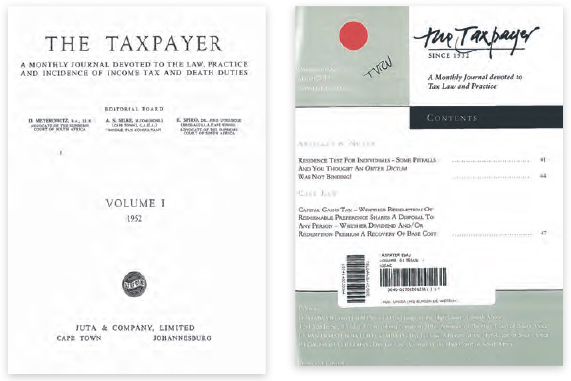
It has retained this format for the last sixty-one years. Its current editors are Dennis Davis, Trevor Emslie, Joe van Dorsten and Peter Dachs, assisted by Clare Emslie.74
It is not approved by the Department of National Education for SAPSE purposes.
2 10 Butterworths South African Law Review (Butterworths SALR) (19541957); Acta Juridica (1958 to date)
The Butterworths South African Law Review appeared for four years from 1954 to 1957. It was published and edited under the auspices of the Faculty of Law of the University of Cape Town. The first editors were Tom Price and Ben Beinart, and as its name suggested, it was published by Butterworth & Co.75
As far back as 1954 the editors of the Butterworths SALR found it necessary to provide a rather lengthy explanation of why in their opinion there was scope for another law journal in South Africa. They reasoned that, firstly, the Butterworths SALR would emphasise the academic study of law, and that they were "desirous of encouraging the comparative and scientific approach to the investigation of legal principles and problems". Secondly, so they argued, because it was an annual and not, for example, a quarterly publication, it would provide a forum for the publication "in complete and unbroken form of monographs somewhat longer than those which it is found possible so to publish in the quarterlies."76
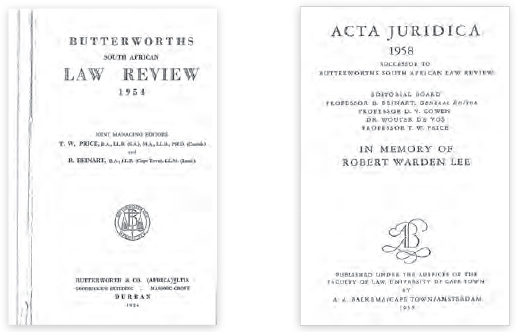
The details of what exactly happened in 1957 have vanished in the mists of time, but what we do know is that in 1958 the Butterworths SALE underwent a name change as well as a change of publisher. Its new name was Acta Juridica and it was published by AA Balkema.77
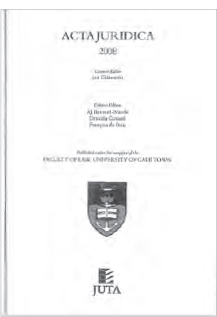
Acta Juridica has become an annual thematic journal. Each year it focuses on a legal issue of the day. It is still published in conjunction with the Faculty of Law of the University of Cape Town, but now by Juta Law.
The managing editor is Jan Glazewski. It a peer-reviewed journal and is approved by the Department of National Education for SAPSE purposes.
2 11 De Rebus Procuratoriis (1956-1978); De Rebus (1979 to date)
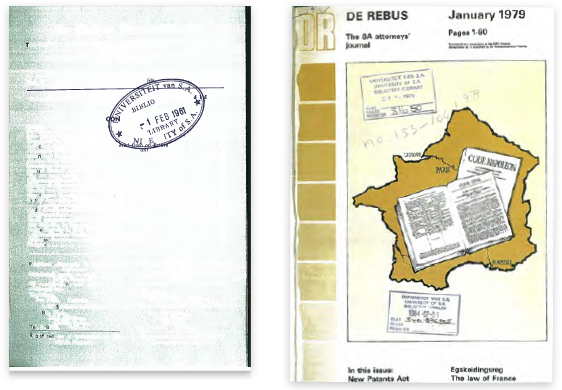
The first issue of De Rebus Procuratoriis was published in September 1956.78 It served as the "official monthly journal of the Incorporated Law Society of the Transvaal".79 Apart from the editorial and a letters column, the early issues consisted almost exclusively of information on the activities of the council and circle councils of the Law Society of the Transvaal.80
The first editor was Theo Boezaart (1956-1962). He was followed by Paai van Niekerk (1962-1967), Eben Louw (1968-1973), Hennie Mellet (1974-1981), Madeline Parker (1981-1982), Francis Bosman (1982-1986), Kallie Wolvaardt (1986-1987), André van Vuuren (1987-1988), Philip van der Merwe (1988-2011) and Kim Hawkey (2011-2013).
The January 1968 issue was the first to be published as a national attorneys' journal by the Association of Law Societies.
In January 1979 it changed its name to De Rebus, with a sub-heading: "The SA Attorneys' Journal" which it still carries today.81
De Rebus is distributed to all practising and retired attorneys, judges and a number of subscribers. It has the largest circulation figures of all South African law journals. It is also available in a "free to read" full-text on-line format.
It is not approved by the Department of National Education for SAPSE purposes.
2 12 Responsa Meridiana (1957 to date)
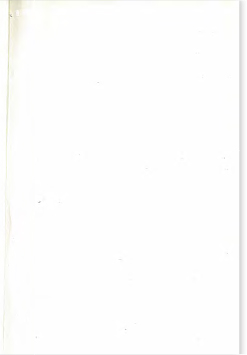
From 1957 to 1963 Responsa Meridiana was published as an in-house student law journal. It is written and produced by the students of the Law Faculties of the Universities of Cape Town and Stellenbosch and is published under the auspices of these two universities.
Initially it was distributed only in these two faculties, but from August 1964 onwards it was published and distributed more widely.
It is an annual journal and now appears in November each year.
The primary objective of Responsa Meridiana82 is to provide students with the opportunity to publish legal articles, "providing them with an international readership, without the stringent submission requirements set by contemporary publications".
Law students are responsible for its entire production from administration to the selection of essays for publication. The editorial board of law students has four to five members of the Law Faculties of the Universities of Cape Town and Stellenbosch. Each of the two universities appoints an editor who in turn appoints editorial members from the applications received.83
It publishes articles by law students from universities all over the world and in all spheres of the law, both public and private.
It is not approved by the Department of National Education for SAPSE purposes.
2 13 Codicillus (1960-2008)

Codicilluss84 was first published in May 1960 and initially served as the newsletter of the Faculty of Law of the University of South Africa. The first editor was Sas Strauss. In later years it was edited by various members of the Department of Jurisprudence of the School of Law at the University until its untimely and lamentable demise in 2008.
It was published twice a year by Unisa Press in Pretoria. Because it was distributed free of charge to all undergraduate and postgraduate law students registered at the University of South Africa, it had huge circulation figures, often in excess of 12 000 copies.
Although it served primarily as a publication forum for both lecturers and senior students in the Faculty of Law, it also published contributions from authors outside the University of South Africa. The column "From the Dean's Desk" is a treasure trove of biographical information on the academic weal and woe of the University's law teachers over a period of nearly fifty years.
In 1991 Codicillus published an "Index" covering the period 1960 to 1990.
It was not approved by the Department of National Education for SAPSE purposes.
2 14 Speculum Judiciale (1962); Scintilla Iuris (1967-1972); De Jure (1973 to date)
Speculum Judiciale85 started as a once-off student publication in 1962 under the auspices of the Juridical Society which was housed in the Faculty of Law of the University of Pretoria.86 It was named after the famous work of the same title by Wilhelmus Durantis. The first (and only) editor of Speculum Judiciale was Louis Harms.87 It was revived in 1967 under a new title: Scintilla Juris}88 From 1967 to 1970 Scintilla Iuris appeared sporadically and in typed form only.89 Two printed numbers of Scintilla Iuris were published in 1971 and 1972, respectively. The editor in 1971 was Miranda Joubert.90
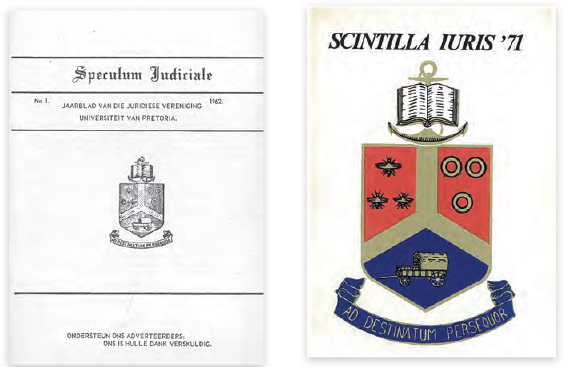
Scintilla Iuris's name was changed to De Jure91 in 1973 and its first editor was Fanie van Jaarsveld.92 Although the first four issues (1967-1970) were not published formally, the editors nevertheless decided to number the 1973 issue of De Jure as volume 6. To complicate matters, the words "Vol IX" and "Aug 1973" appeared on the front cover of the 1973 issue, which created the impression that it was then already in its ninth year of publication. This confusion was resolved in 1974, when the words "Jaargang 7" were printed on the front cover, while the two issues published in 1974 were numbered volumes 1 and 2, respectively. Unlike other periodicals which usually use the term "volume" to mark the number of years of its existence, De Jure uses the word "jaargang" instead. It uses the words "volume 1" and "volume 2" to indicate the two individual numbers that are published annually. This trend has continued. Thus, the two issues of De Jure published in 2012 were referred to as "Jaargang 45, Vol 1" and "Jaargang 45, Vol 2", respectively.
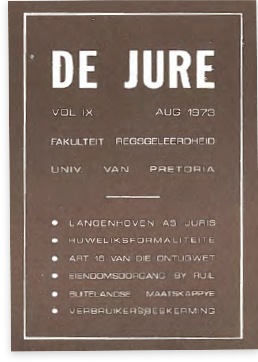
There are usually two numbers (ie, "volumes") annually, while a third volume is occasionally published.93
It is a general law journal with wide ranging articles. It is edited under the auspices of the Faculty of Law of the University of Pretoria and is published by LexisNexis Publishers. The current editor is Steve Cornelius.
A consolidated index (1973-1986) was published in 1986.94 An electronic consolidated index (1987-2003) is available on the University of Pretoria's website. Although it is still published in hard copy, recent volumes are also available online, in full text, free of charge.95
It is a peer-reviewed journal and is approved by the Department of National Education for SAPSE purposes.
2 15 Speculum Juris (1965 to date)

Speculum Juris96 was first published in 1965 as an annual of the Faculty of Law and Juridical Science of the University College of Fort Hare.97 According to the Preface to the 1965 edition, Speculum Juris was "born from a desire on the part of the students to have a medium through which they can give expression to their own interpretation of the material of study with which they have been occupied".
The editors of the first number of Speculum Juris were Francois de Villiers, Duke Makoba and Louis Makua.98
Presently Speculum Juris is published twice a year under the joint auspices of the Nelson R Mandela School of Law at the University of Fort Hare and the Faculty of Law of Rhodes University. The current managing editor is Boyce Wanda and it is published by LexisNexis Publishers.
It is a peer-reviewed journal and is approved by the Department of National Education for SAPSE purposes.
2 16 The Magistrate/Die Landdros (The Magistrate) (1965 to date (uncertain)

The Magistrate is the official journal of and published under the auspices of the Magistrates' Association of South Africa. In May and again in June 1965, a roneoed Newsletter-Nuusbriefwas sent to all magistrates' offices in the Republic. The first number of The Magistrate replaced the earlier Newsletters. Most of the material published in the two Newsletters was reprinted in subsequent numbers of The Magistrate.99
Although the first number does not provide the name of the editor, it is safe to assume that the editor was Ivor Dekenah,100 because everything written in volume 1 was written by I Dekenah.101
In later years it was published quarterly by Digma Publishers. The most recent edition that I consulted for the purposes of the present survey, was edited by Pieter Theron, at the time the Chief Magistrate of Randburg.102 Some websites refer to the 1996 edition, and others to the 2005 edition as the final volume. All attempts to ascertain from the Department of Justice whether or not The Magistrate is still published, were fruitless.
It was not approved by the Department of National Education for SAPSE purposes.
2 17 The Comparative and International LawJournai ofSouthern Africa (CILSA) (1968 to date)

The Comparative and International Law Journal of Southern Africa was first published in March 1968. It is published three times a year, under the auspices and editorship of the Institute of Foreign and Comparative Law of the University of South Africa.103
CILSA aims to be a forum for the discussion of questions of comparative and international law, both private and public, and to provide information on legal developments in Southern Africa.104
An important regular feature in each issue of CILSA is the review of current legal developments in Lesotho, Namibia, South Africa, Swaziland, Zambia and Zimbabwe.105 It is the "only internationally available, regular update of legal developments in these countries".106
The publication of CILSA is sponsored by the VerLoren van Themaat Fund for International Law.107 Its first editors were Clive Mostert and Robert Pace. The editors of the 2013 edition of CILSA are André Thomashausen, Johan Joubert, Neville Botha, Douglas Mailula, Funmi Abioye and Mariki Rudolph.
It is a peer-reviewed journal and is approved by the Department of National Education for SAPSE purposes.
2 18 UPE Regstydskrif /UPE Law Journal (1969-1972108); Obiter (1979 to date)
The UPE Law Journal was first published in 1969 by and under the auspices of the Faculty of Law of the University of Port Elizabeth. The last available number I have accessed is that of 1972. The first editor of the UPE Law Journal was Andries Celliers. Although it was called a "Law Journal", its external format, consisting of roneoed copies which were stapled together, was rather modest. However, the contributions published in it were of a "proper law journal" standard. The UPE Law Journai was the de facto predecessor of Obiter.

Obiter109 was first published in 1979 under the auspices of the Faculty of Law of the University of Port Elizabeth and under the editorship of Anthony Mercer and Patrick Scott.110 Initially it was published annually. It was intended to be an academic publication, but also to include "a coverage of the annual events of the [UPE] Law Society as well as events held in conjunction with the Faculty of Law" at the University of Port Elizabeth.111
Now it is published three times a year, under the auspices of the Faculty of Law of the Nelson Mandela Metropolitan University in Port Elizabeth.
The current editor is Adriaan van der Walt.
Obiter is a peer-reviewed journal, which is approved by the Department of National Education for SAPSE purposes.
2 19 Meditationes Medii: Journal of the Law Students of the University of the Free State/Tydskrif van die Regstudente van die Universiteit van die Vrystaat (1969-1974; 2009 to date)

Meditationes Medii112 is a students' law journal published annually under the auspices of the University of the Orange Free State (as that university was then known). It was first published in 1969 under the editorship of PJ Smith. Six volumes were published between 1969 and 1974.
After an interruption of thirty-six years it was re-launched in 2009 under the editorship of Marda Horn. The 2009 edition of Meditationes Medii contains the seven best LLB dissertations of the Law Faculty of the University of the Free State during that year. The criteria for inclusion in Meditationes Medii are that the dissertation must be of a "publishable standard" and have obtained a distinction during the assessment process.113
Subsequent editions have followed the same format as that of 2009. The current editor is Manie Moolman. It is not approved by the Department of National Education for SAPSE purposes.
2 20 Natal University Law Review (NULR) (1972-1984) / Natal University Law and Society Law Review (NULSlR (1985-1990)
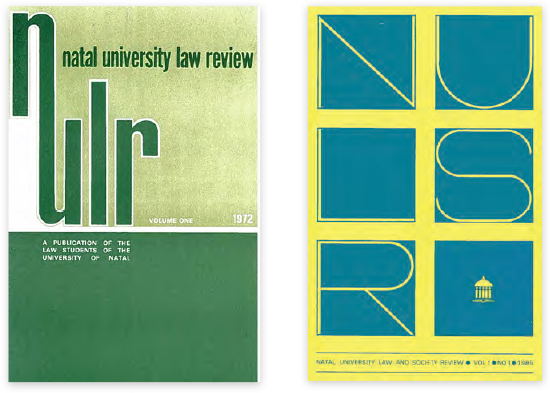
The Natal University Law Review was first published in 1972. Its aim was to "make teaching more of a two-way process in which an active role on the part of students is stressed". Its first editor was Clyde Bartel. It served primarily as a forum in which law students of the University of Natal could publish their own research.114
It ceased publication in 1984, but was re-launched as the Natal University Law and Society Law Review. The first editor of the NULSLR was Chiman Patel. The reason for the re-launch was to replace the NULR "with a journal devoted to an interdisciplinary analysis of law and its role in society".115 It was published under the auspices of the Centre for Socio-Legal Studies.116 From 1985 to 1988 it was published annually; thereafter it was published twice a year. The last number of NULSLR was published in November 1990 under the editorship of David McQuoid-Mason and Kevin Ferguson-Brown.
It was not approved by the Department of National Education for SAPSE purposes.
2 21 Crime Punishmentand Correction. NICRO Criminological Journal/ Kriminologiese Tydskrif. Misdaad Strafen Hervorming (Crime Punishmentand Correction) (1972-1976); South African Journal of Criminal Lawand Criminology (SACC)/Suid-Afrikaanse Tydskrif vir Strafreg en Kriminologie (SASK) (1977-1987); South African Journal of Criminal Justice/Suid-Afrikaanse Tydskrif vir Strafregspleging (SACJ) (1988 to date)

Crime Punishment and Correction was first published in April 1972 by the National Institute for Crime Prevention and Rehabilitation of Offenders (NICRO). It was published twice a year and its first editors were Roland Graser and Thea Toussaint van Hove. Later volumes were published quarterly. The fifth and final volume of Crime Punishment and Correction appeared in November 1976. It was succeeded by the South African Journal of Criminal Law and Criminology.
The SACC was first published in April 1977 by Butterworth Publishers under the editorship of Roland Graser and Jan van Rooyen, in collaboration with NICRO. The last number of the SACC was published in 1987 under the editorship of David McQuoid-Mason.
In 1988 the SACC was superseded by the South African Journal of Criminal Justice. The first editor of the SACJ was John Milton. It is published by Juta Law.
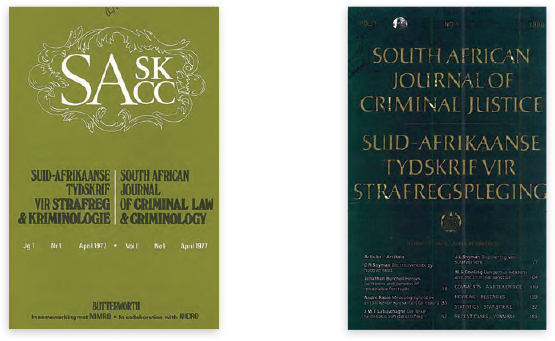
It is an accredited, specialist legal journal which publishes articles, comments, surveys of recent cases and book reviews in the field of criminal justice, with an emphasis on Southern Africa law. The focus of the journal is criminal law, criminal procedure, evidence, international criminal law and criminology. It is published three times a year. The current editors are Shannon Hoctor, Stephan Terblanche and Tarryn Winchester.
It is a peer-reviewed journal, which is approved by the Department of National Education for SAPSE purposes.
2 22 South African Yearbook of International Law/Suid-Afrikaanse Jaarboek vir Volkereg (SAYILL) (1975 to date)

The South African Yearbook of International Law was first published in 1975 under the editorship of Hercules Booysen. It is published by the VerLoren van Themaat Centre for Public Law Studies of the University of South Africa. At the time, the VerLoren van Themaat Centre was controlled jointly by the Department of Constitutional and Public International Law, and the Institute of Foreign and Comparative Law, both of the University of South Africa.117
The SAYIL is the only South African journal devoted solely to international law. It is the leading reference source on the development of international law in South Africa and covers a wide variety of current topics in international law. As its title suggests, it is published annually.
It is usually published only a year or more after the year in which the legal developments discussed took place.
The editors of the most recent edition of SAYIL (2011) are Neville Botha and Marinus Wiechers. It is a peer-reviewed journal and is approved by the Department of National Education for SAPSE purposes.
2 23 Tydskrif vir Regswetenskap (TRW)/Journal for Juridical Science (JJS) (1976 to date)
The Tydskrif vir Regswetenskap was first published in 1976. It seeks to bridge the gap between law and other academic disciplines. Thus, albeit anchored in law, the TRW has a multi-disciplinary and inter-disciplinary orientation. Although the TRW prefers contributions that reflect basic legal research, it does not restrict itself to basic research.118
It is edited and published twice a year under the auspices of the Faculty of Law of the University of the Free State. The first editor was Dirk C du Toit. The current editors are Charles Ngwena, Shaun de Freitas, David McQuoid-Mason, Johann Neethling and Andries Raath.119
It is a peer-reviewed journal, which is approved by the Department of National Education for SAPSE purposes.
2 24 Tydskrif vir die Suid-Afrikaanse Reg (TSAR)/Journal of South African Law (JSAL) (1976 to date)
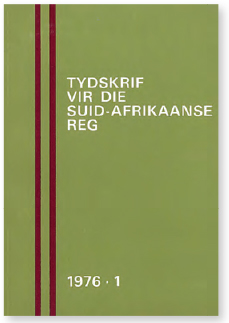
The Tydskrif vir die Suid-Afrikaanse Reg publishes "researched-based articles on law". It publishes articles covering a broad spectrum of law, including aspects of private law, mercantile law, constitutional law, criminal law, public law, legal philosophy and legal history.120
It is published quarterly and is edited and published under the auspices of the Faculty of Law of the University of Johannesburg (previously the Rand Afrikaans University). It is published by Juta Law. It publishes articles in Afrikaans, Dutch and English.
The first editors were JC van der Walt, Schalk van der Merwe and Ig Rautenbach. The current editor is Jean Sonnekus.
It is a peer-reviewed journal and is approved by the Department of National Education for SAPSE purposes.
2 25 South African Insurance Law Journal (SAILJ) (1977-1985)
The South African Insurance Law Journal was first published in 1977 by Abe Hyman of Hyfam Promotions. He was also the editor of and sole contributor to the first volume. In subsequent numbers there were contributions from a wide range of authors.
The aim of the SAILJ was to present quarterly loose-leaf issues that contained a "series of articles and notes on selected topics in South African insurance law". It concentrated on articles which explained the law "as we understand it to be rather than express opinions on what it should be or speculate on what it might become".121
Later editions, including the final one in 1985, were published by CLC Publications. The editors of the final number were Andrew Borrowdale, Richard Brusser, Julian Sher, Dennis Davis, Hilton Stanniland, Joe van Dorsten and Gavin Urquhart.122
2 26 Moderne Besigheidsreg /Modern Business Law (MBR/MBL) (1979-1988)
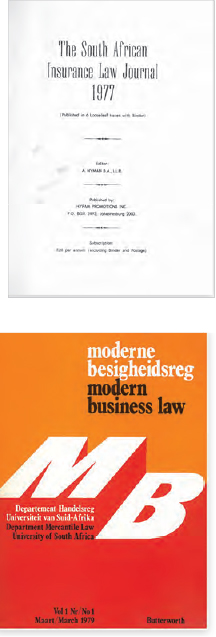
Modern Business Law was published twice a year from March 1979 to July 1988. Its aim was to "provide an in-depth yet practical analysis and discussion of various topics in the field of mercantile and business law for the benefit of lawyers, academic as well as practising".123 The publication of MBR/ MBL was made possible by financial contributions from the Tax and Business Law Centre of the University of South Africa, as well as the Sidney Bam Legal Publications Trust.124
It was published under the auspices and editorship of the Department of Mercantile Law of the University of South Africa, in conjunction with Butterworth Publishers. The first editors were Pierre Brooks, Esmé du Plessis and Marlene Jacobson. They were later joined by Adolph Landman, Hennie Mellet and Gerrie Swart.
After a dispute between the Tax and Business Law Centre of the University of South Africa and the publishers of MBR/MBL, it ceased publication in 1988.
The void left by MBR/MBL was filled in 1989 by a new journal: SA Mercantile Law Journal/SA Tydskrif vir Handelsreg.125
2 27 Lawyers for Human Rights Newsletter (1979-1982); Lawyers for Human Rights Bulletin (1983-1984); South African Journal on Human Rights (SAJHR (1985 to date)
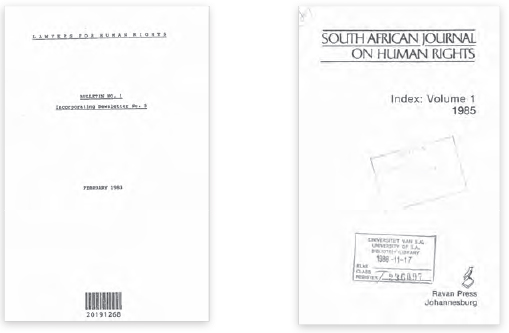
The Centre for Applied Legal Studies of the University of the Witwatersrand was founded in 1978 and the Legal Resources Centre in 1979. The year 1979 marked the First International Conference on Human Rights in South Africa, held at the University of Cape Town. In pursuance of this Conference in 1979, an association of lawyers, Lawyers for Human Rights was founded in June 1980. Initially Lawyers for Human Rights produced a Newsletter to keep in touch with its members. In 1983 this was replaced by the Bulletin of Lawyers for Human Rights126 which in turn was the predecessor of the South African Journal on Human Rights.
The SAJHR was first published in 1985 under the editorship of Christina Murray, Geoffrey Budlender, John Dugard, Nicholas Haysom, Gilbert Marcus, Laura Magan, Etienne Mureinik and Johan van der Vyver.127 It was published under the auspices of the Centre for Applied Legal Studies of the University of the Witwatersrand, by Ravan Press, Johannesburg.128
The SAJHR was published during the first of many States of Emergency in South Africa during the 1980s and early 1990s. It is no co-incidence that it had its genesis during that period of our country's turbulent history. In a carefully worded editorial in the first number in 1985 it was stated that the journal marked "another stage in the mobilization of human rights opinions and a further attempt to enlist more lawyers in the cause of human rights".129
Its content comprises articles, cases and comments on human rights. The SAJHR is frequently published as a special focus volume. For example, in 2007 special issues on "Substantive Equality, Social Rights and Women: A Comparative Perspective" as well as "Sexuality and the Law" appeared. The journal provides a forum for the expression of views on, and is committed to the cause of, human rights. Although the SAJHR is intended primarily for lawyers, it has a wider appeal and is also read by non-lawyers.
It is now published by Juta Law. The current editors are Catherine Albertyn, Jackie Dugard, Beth Goldblatt, Raylene Keightley, Jonathan Klaaren, Kirsty McLean, Bonita Meyersfield, Muriel Mushariwa and Sanele Sibanda.130
It is a peer-reviewed journal, which is approved by the Department of National Education for SAPSE purposes.
2 28 Industrial Law Journal (ILJ (1980 to date)
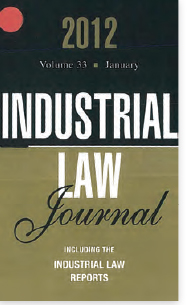
The Industrial Law Journal was first published in 1980 under the editorship of Halton Cheadle and Etienne Mureinik. It is published by Juta Law under the auspices of the Centre for Advanced Legal Studies of the University of the Witwatersrand.
It is the premier South African labour law reporter. It covers judgments and awards handed down by the Labour Court, the Labour Appeal Court, the Commission for Conciliation, Mediation and Arbitration, Bargaining Councils and private arbitration bodies, including the Arbitration Foundation. Also covered are labour-related judgments from the Constitutional Court, the Supreme Court of Appeal, the Land Claims Court and the Pension Funds Adjudicator. It also publishes relevant judgments of neighbouring states.
It is published monthly and every fourth issue includes articles, notes and case discussions.
The current managing editor is Adolph Landman and its editors are Carole Cooper, Christine Vosloo and June Wilson.
Over the years a number of cumulative indices of the ILJ were published. The most recent and voluminous of these is the Industrial Law Journal Cumulative Index 19802010 by Christine Vosloo. It is published in two volumes, running to 2 276 pages.131
It is a peer-reviewed journal, which is approved by the Department of National Education for SAPSE purposes.
2 29 South African Society of Legal Historians Newsletter/Suider-Afrikaanse Vereniging van Regshistorici Nuusbrief (November 1983 to May 1986); South African Society ofLegal Historians Bulletin/Suider-Afrikaanse Vereniging van Regshistorici Bulletin (November 1986-1991); Fundamina. A Journal ofLegal History (1992 to date)
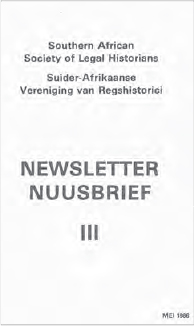
The Southern African Society of Legal Historians was established on 11 January 1983. One of its aims was to publish a legal history journal. But it took ten years before this happened.132 At first, reports of the Society's activities were published in a modest Newsletter, the first of which appeared in November 1983.133 It does not provide the names of any editors, and one has to assume that the management committee of the Society took responsibility for its compilation and publication.134 This Newsletter was one in the true sense of the word, largely comprising information on the activities and research projects of its members. A second Newsletter was published in December 1984; and a third one, in a new A5 format, in May 1986. The latter publication was the first to publish contributions of a more academic nature, and it introduced a fixed format for future editions, namely "an editorial; no less than three articles of a legal historical nature; a profile of an eminent Southern African legal historian; a profile of an important legal historical research institute or centre; a miscellaneous section ... and information on recent Southern African legal historical writings".135
In 1986 the Society changed the name of its mouthpiece to the Bulletin.136 The format of the Bulletin followed the guidelines laid down in the May 1986 issue of the Newsletter.
Neither the Newsletter nor the Bulletin sought the status of a fully fledged legal periodical.
Ten years after the Society was founded, it decided that the time had arrived to publish a legal historical journal. Fundamina. A Journal of Legal History was born. It was and remains a journal that publishes legal historical research.137 The first editors of Fundamina were Philip Thomas, Duard Kleyn and Ben Stoop.
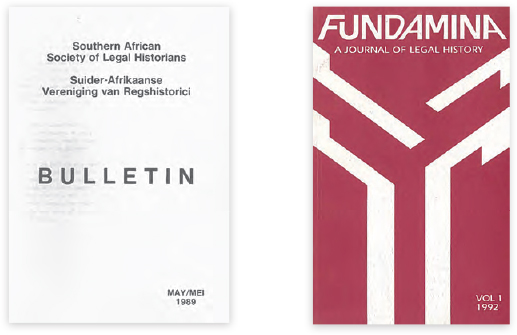
Initially Fundamina was published annually, but from 2005 it was published twice a year. It publishes articles in English, Afrikaans, Dutch, French, Italian, Spanish and German. It is printed and published by the University of South Africa. The current editors are Rena van den Bergh and Gardiol van Niekerk.138
Fundamina is included in the Vlaamse Academisch Bibliografisch Bestand voor de Sociale en Humane Wetenschappen (VABB-SHW).
It is a peer-reviewed journal and is approved by the Department of National Education for SAPSE purposes.
2 30 SA Tax Journal (SA Tax J) (1985-1988)139
The SA Tax Journal was first published in September 1985 by Butterworth Publishers, under the auspices of the Centre for Continuing Tax Education of the University of the Witwatersrand. The first editors of the SA Taxjweve Hymie Levin, Abe Swersky, Louise Tager, Henry Vorster and Basil Wunsh.140
In its first editorial it was said that "there is a deficiency in the range of available [tax] publications" and that the existing publications "are commercially based, and the materials are, therefore, unashamedly directed towards day-to-day tax practice".141 The first volume comprises numbers 1 to 4 (Sept 1985 - Nov 1986) and volume 2 comprises numbers 1 to 4 (Jun 1987 - Jun 1988).

The SA Tax J published critical analyses of tax judgments, research studies, not only of practical but also of academic interest, short notes on tax law and procedure and book reviews.
It was not approved by the Department of National Education for SAPSE purposes.
2 31 SA Publiekreg/SA Public Law (SAPR/PL) (1986-2009); Southern African Public Law (SAPLL) (2010 to date)
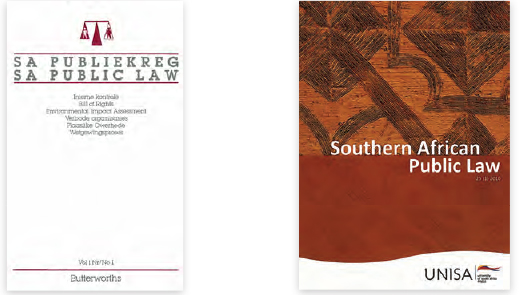
SA Public Law was first published in June 1986 by Butterworth Publishers. Although the "Editorial" to the first editions does not indicate that any specific law faculty initiated the journal, the bulk of the editorial work load was shared by academics in the Departments of Constitutional Law of the Law Faculties of the University of Pretoria and the University of South Africa.
In the "Editorial" to its first number, the editors acknowledged that there had to be good reasons for the publication of yet another South African legal periodical. They argued that because of far-reaching developments and changes in South African public law, and more specifically, its constitutional and administrative law, during the 1980s, public law had become of huge relevance to all lawyers. They further pointed out that the heightened level and intensity of interaction between the "state" and individuals necessitated specialised juridical examination and comment.142
The aim of SA Public Law is to provide expert analyses and in-depth discussion of constitutional and administrative issues in South Africa. The first editors were Henning Viljoen and Dawid van Wyk.
With effect from 2010 SA Public Law's title was changed to Southern African Public Law (SAPL). SAPL is now published by the VerLoren van Themaat Centre for Public Law Studies of the University of South Africa. Its editor is Margaret Beukes.
It is a peer-reviewed journal and is approved by the Department of National Education for SAPSE purposes.
2 32 Consultus (1988-1999); Advocate (2000 to date)
Consultus served as the South African Bar journal. The editorial to the first number stated that it "will endeavour to promote the image of the Bar, to make known advocates' views on both matters relating to the [advocates'] profession and matters of public interest, and also to further law reform".143
It was published by the General Council of the Bar in South Africa. The first editor was JPJ Coetzer.
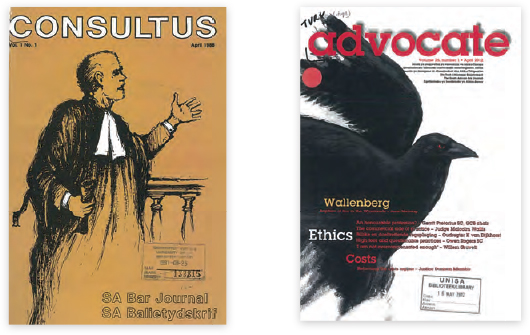
In 2000 Consultus changed its name to Advocate. It remains the official journal of the General Council of the Bar of South Africa. It appears quarterly and its circulation includes all practising advocates, judges, and a large number of other lawyers, senior government officials and politicians.144
Apart from articles and contributions with a strong practical slant, it also publishes news from the different Bars, a judges' forum and other shorter contributions of general interest to practising advocates.
Hennie Mellet was the first editor of the Advocate and he still holds the editorial reins.
It is not approved by the Department of National Education for SAPSE purposes.
2 33 South African Mercantile Law Journal/Suid-Afrikaanse Tydskrif vir Handelsreg (SA Merc LJ (1989 to date)
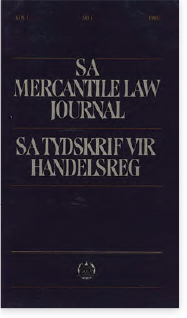
It was first published in 1989 and succeeded Modern Business Law.145 It is published by Juta Law under the auspices of the Department of Mercantile Law of the University of South Africa. It is published three times a year, with an occasional fourth special number which is either thematic or contains seminar proceedings.
It is a specialised journal devoted to publishing material in the field of mercantile and commercial law. It contains articles, analyses, case comments and book reviews dealing with matters of commercial law. It is not intended to be a businessman's journal, but is aimed at practitioners in the field of commercial law.
In 1999 it published an "Index" covering the period from 1989 to 1999.
The first editor was Esmé du Plessis, with assistant editors Jopie Pretorius and Johan van Niekerk. The current editor is Alastair Smith.
It is a peer-reviewed journal, which is approved by the Department of National Education for SAPSE purposes.
2 34 The Witwatersrand University Student Law Review (WUSLR (19891994); Student Law Review (SLR) (2002); Wits Student Law Journal of Southern Africa (WSLJ (2012 to date)
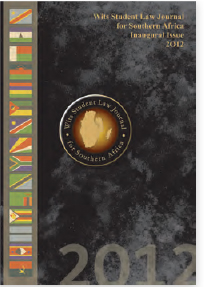
The Witwatersrand University Student Law Review was first published in 1989 under the auspices of the Wits Law Students' Council. Its principle aims were to provide students with an opportunity to have original work published and to encourage independent research. Its final volume was published in 1994.
Seven years after the demise of the WUSLR, the Wits Law Students' Council revived the WUSLR in the guise of the Student Law Review. From the available materials it seems that only one volume of the SLR was published.
The most recent attempt by the Wits Law Students' Council to resurrect their law journal resulted in the publication of the Wits Student Law Journal of Southern Africa as from 2012.
The aim of the WSLJ is to provide a "platform for legal discourse" and to encourage "legal commentary on issues affecting Southern Africa".146
It aims to publish articles dealing with human rights and social justice; taxation law; environmental and energy law; immigration law including citizenship and asylum; criminal law; competition law; illegal substance regulations and policies; corporate law and tourism law and regulations. It is clear that the WSLR has a definite slant towards public law, and more specifically, aspects of public law relevant to the Southern Africa region.
It is not approved by the Department of National Education for SAPSE purposes.
2 35 Stellenbosch Law Review (Stell LR)/Stellenbosch Regstydskrif (1990 to date)

The Stellenbosch Law Review was first published in 1990 under the editorship of Lourens du Plessis. It provides a forum for the discussion of topical legal issues in various fields. Because it regards itself as a "law review", the emphasis is on providing insight rather than just overviews.147
It strives to maintain a balance between a wide variety of specialist fields and legal subjects of general interest.148
It is published three times a year by Juta Law under the auspices of the Faculty of Law of the University of Stellenbosch. The current editor is Geo Quinot.
It is a peer-reviewed journal, which is approved by the Department of National Education for SAPSE purposes.
2 36 South African Human Rights and Labour Law Yearbook (SAHRLLY) (1990-1992); South African Human Rights Yearbook (SAHRY) (19931998)
The South African Human Rights and Labour Law Yearbook was first published in 1990 by Oxford University Press under the auspices of the Centre for Socio-legal Studies of the University of Natal (as it was then known). Its first editors were Michael Robertson, Megan Seneque and Chris Albertyn. Initially it consisted of an annual review that sought to review developments and changes in two key areas: human rights and labour relations. The focus was not on law alone: it included important trends and events, often the precursors of legal change during a tumultuous period in South Africa's history.149
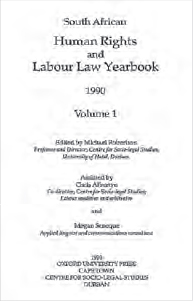
In 1993 its name was changed to the South African Human Rights Yearbook. During the latter part of its existence its focus was on legal and related developments in specific areas of human rights and it documented the legal, social and political implications of the transition to democracy and the deregulation of apartheid.
The SAHRY covered developments in the areas of capital punishment; children's rights; conscription; constitutional developments; detention; education; elections; the environment; health; homelands; land; legal representation; local government; policing; prisoners' rights; sexual orientation; and women's rights.
Although many of these topics are still of major importance and relevance, others, such as capital punishment, conscription and homelands have become obsolete for various reasons, which contributed to the SAHRYs demise in the late 1990s.
The final number was published in 1998 under the editorship of Chuck Scott, and under the auspices of the Centre for Socio-legal Studies of the University of KwaZulu-Natal.
2 37 Executor (1991-2000)

A new era dawned for sheriffs of the court when the Sheriffs Act150 was adopted in 1986. Executor was launched as a direct result of the passing of this Act. It was the first official publication for the sheriffs of the higher and lower courts in South Africa and its neighbouring states. It aimed to deal with the rights, powers and duties of the sheriff. To ensure that Executor would have a practical approach, extensive use was made of articles and other contributions from the ranks of sheriffs.151
It was published twice a year, in May and November each year. The editor of Executor was CP Bezuidenhout.
It was not approved by the Department of National Education for SAPSE purposes.
2 38 Juta's Business Law (JBLL) (1993-2009)

Juta s Business Law was first published in 1993 by Juta & Co. It was written mainly by lawyers, primarily for people in business rather than for other lawyers. It aimed to draw its readers' attention to some recent changes to the law and also to repeat information which might need further emphasis. It set out to produce clear, practical articles, free of jargon or legalese.152 The articles published in JBL covered a wide range of topics, including contracts, banking, tax, methods of payment, damages, insurance, wills and immaterial property law, to mention but a few.
The first editors were Coenraad Visser and Peter Dawe.
Although it was not approved by the Department of National Education for SAPSE purposes, the publishers paid contributors a nominal honorarium.
The most recent number was edited by Coenraad Visser and Alastair Smith and published in July 2009. Its publication has been suspended indefinitely.
2 39 The South African Journal of Environmental Law and Policy (SAJELP) (1994 to date)

The South African Journal of Environmental Law and Policy is an independent journal that concentrates on environmental law and policy. Its aim is to provide an "academic forum in which to focus on issues relating to environmental law and policy". At the time of its launch it was a joint project of the School of Law of the University of Natal,153 Pietermaritzburg; the Institute of Environmental Law of the University of Natal,154 Durban and the National Environmental Law Association.155
It publishes contributions on all aspects of environmental law and policy, including environmental governance; regulation of environmental decision-making; compliance monitoring and enforcement measures; liability for environmental pollution and degradation; cultural heritage, biodiversity and protected areas; and recent case law.
Contributions by lawyers, scientists, economists, and social scientists are published in SAJELP.
The current editors are Michael Kidd, Jan Glazewski, Jeremy Ridl, Ed Couzens, Alexander Paterson and Louis Kotze.156
It is a peer-reviewed journal, which is approved by the Department of National Education for SAPSE purposes.
2 40 Law Democracy & Development (LDD) (1997 to date)
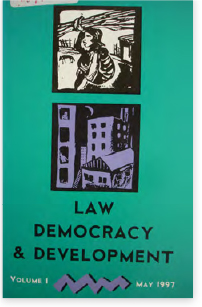
Law Democracy & Development is published under the auspices of the Faculty of Law of the University of the Western Cape. The first issue, which appeared in May 1997, was devoted to the Labour Relations Act.157 LDD set out to build on "the traditions established by UWC [the University of the Western Cape] and by the Law Faculty during the struggle for democracy". The journal is "concerned with the role of every branch of law and legal institutions in promoting or obstructing democracy and development within a specific social context".
LDD sees law as a social process and sets out to examine the way in which law regulates, promotes or impedes the building of democracy and socioeconomic restructuring in South Africa. It is therefore neither a general law journal nor specialised in any single branch of the law.158
Originally published by Juta & Co, it went online in 2010.159 It is published by the University of the Western Cape Community Law Centre.
Editorial comment and summaries of all articles appear in French as well as in English. The current editor-in-chief is Jamil Mujuzi.
It is a peer-reviewed journal and is approved by the Department of National Education for SAPSE purposes.
2 41 Potchefstroomse Elektroniese Regsblad (PER)/Potchefstroom Electronic Law Journal (1998 to date)
The Potchefstroomse Elektroniese Regsblad is published by the Faculty of Law of the North-West University. It was the first online-only legal periodical in South Africa.

It is included in the International Bibliography of the Social Sciences (IBSS).160 Another first for PER is the fact that it was the first South African legal journal to provide electronic open access. And that at a stage when "open access" was regarded as a taboo by most journals and publishers.
PER publishes contributions in English, Afrikaans, German and Dutch that are relevant to the theme "Development in the South African Constitutional State". Most contributions deal with some aspect of constitutionalism or the law relating to development. While constitutionalism and development needs continue to be the main themes, contributions on any aspect or discipline of the law are published provided that the main themes are addressed.161
Its first editor was Francois Venter (1998-2012) while the current editor is Christa Rautenbach.162
It is a peer-reviewed academic periodical, which is approved by the Department of National Education for SAPSE purposes.
2 42 Without Prejudice (2001 to date)
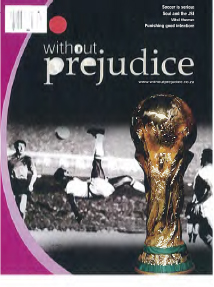
Without Prejudice is a monthly corporate law publication aimed at not only the legal fraternity but also chief executive officers and managing directors, financial directors and marketing directors. Its articles provide practical advice on the practice of commercial law. In addition it provides a section on what is happening in legal firms throughout the country, and on lifestyle getaways and restaurant reviews; and also news from London and motoring and book reviews.
It was first published in October 2001 and is supported by eleven of South Africa's leading corporate law firms.163
It is not approved by the Department of National Education for SAPSE purposes.
2 43 African Human Rights Law Journal (African Human Rights LJ ) (2001 to date)

The African Human Rights LawJournal was first published in 2001 under the auspices of the Centre for Human Rights of the University of Pretoria. It is published twice a year, in March and October, by Juta Law.
As the title suggests, it focuses on topics dealing with human rights that are of relevance to Africa, Africans and those studying Africa.164 The first editors were Christoph Heyns and Frans Viljoen.165 The current editors are Frans Viljoen, Magnus Killander, Tshepo Madlingozi and Annelize Nienaber.166
It is a peer-reviewed journal and is approved by the Department of National Education for SAPSE purposes. It is also included in the Bibliography of the Social Sciences.167
2 44 South African Journal for Bioethics and the Law (SAJBL) (2007 to date)

The South African Journal for Bioethics and the Law is an online bi-annual journal aimed at the health professions, covering matters related to ethics, law, human rights and related matters.168 Its editors are Ames Dhai and David McQuoid-Mason.
It is a peer-reviewed journal, which is approved by the Department of National Education for SAPSE purposes.
2 45 Pretoria Student Law Review (PSLR (2007 to date)
A student-driven initiative created the Pretoria Student LawReview (PSLR). It provides an interactive forum in which students, academics and legal professionals can discuss topical legal matters.

The first editorial of the PSLR states that it "has been started with two main aims - to stimulate critical legal thought amongst legal students and to develop students' writing and research skills".
It is a student-run journal comprising contributions by law students and lecturers of the University of Pretoria. The first volume was published at the beginning of 2008 (2007 edition). Subsequent editions, volumes 2 to 4, are available in both hard copy and electronic format.
Copies of the PSLR are distributed to all law faculties in South Africa and many universities in Africa. Copies are also sent to judges and law firms around the country. 169
It is not approved by the Department of National Education for SAPSE purposes.
2 46 Journal for Estate Planning Law/Tydskrif vir Boedelbeplanningsreg (2007)

The Journal for Estate Planning Law was published under the auspices of the Faculty of Law of the University of the Free State. The first and only year of publication was 2007. The editor was Elizabeth Snyman-Van Deventer.170
It was not approved by the Department of National Education for SAPSE purposes.
2 47 Litnet Akademies (Regte) (2011 to date)
Litnet Akademies (Regte) is a sub-division of Litnet Akademies. The latter, in turn, is a sub-division of Litnet, an online academic periodical that publishes peer-reviewed research articles in Afrikaans.171
Litnet Akademies (Regte) was first published in 2011. With a marked decrease in the number of contributions published in the Afrikaans language in the conventional law journals, as well as an editorial decision by a number of journals to accept only English contributions, Litnet Akademies (Regte) will provide an important forum for authors wishing to have their research published in Afrikaans.
It is a peer-reviewed journal and is approved by the Department of National Education for SAPSE purposes.
LitNet Akademies (Regte) is completely integrated with the Litnet hypertext environment. Articles published on Litnet Akademies are supplemented by Litnet interviews, video clips from Litnets You Tube channel and online debates.
The first and also current editor of Litnet Akademies (Regte) is Johann Neethling.172
2 48 SADC Law Journal (SADC LJ) (2011 to date)

The SADC Law Journal was first published in 2011. It is published annually and is concerned with legal aspects of regional integration in the Southern African Development Community (SADC). One of its aims is to enlighten its readers on the importance of the SADC Tribunal, not only in the Southern Africa region, but also at international level. It also provides a platform for scholars and legal practitioners to share their views on various aspects of the SADC Treaty, SADC protocols and other SADC norms.173
The editor-in-chief is Evance Kalula, who is assisted by a team of editors from SADC countries.
The first number does not indicate the name of the publishers or where it is published.
It is not approved by the Department of National Education for SAPSE purposes.
3 Conclusion
It has been pointed out that in South Africa there are a large number of legal journals relative to the size of the academic community in the discipline of law.174 At the time of writing the Academy of Sciences of South Africa (ASSAf) was in the process of compiling a report on the current state of South African accredited law journals. It would therefore be prudent to reserve any interpretational comment on the current number of South African legal periodicals, and more specifically on the continued viability of such a large number, until such time as the ASSAf report has been finalised and its findings made public.
I shall confine myself to an observation that was made all of twenty-three years ago: "in a developing country such as South Africa there are far too many law faculties and, almost by the same token, too many species in the genus of law journals."175 During the past twenty-three years at least thirteen new law journals have seen the light of day, but some were short-lived. Whilst it may be argued that there is no need or room, given the rather small market, for yet another legal journal, it has also been argued that there will always be room for another journal of high quality.176
Finally, it is probably not far-fetched to speculate that in ten years' time a large percentage of the journals listed above will be available in an online-only format, for two main reasons: firstly, the ever-increasing cost of producing and distributing journals with a low print run in hard copy; and secondly, the international initiatives that are under way to develop open access to information arising from publicly funded research.177 The European Union has already put forward proposals in this regard. Although there is some way to go before the European Union will agree on a detailed system, early in 2013 Ministers from the twenty-seven member countries expressed their support for proposals to develop broader and more rapid access to scientific publications for researchers, to build on the findings of publicly funded research.178
*I would like to thank a number of individuals who have assisted me in my research on South African legal journals. First, Nico Ferreira of the Samuel Pauw Library, University of South Africa for magnanimously allowing me access to his private collection of first numbers of South African journals and magazines. Many of the images reproduced below come from his collection. Secondly, my research assistant for the last two years, Evelyn Andrews, for her unfailing enthusiasm and diligence in locating, photocopying and scanning materials relevant to the present project. Thirdly, Rosemary Kuhn, Librarian at the University of KwaZulu-Natal for providing assistance and access to a number of rare and early Natal law journals which I could not find anywhere else. And finally, many colleagues at my own university as well as other South African universities who assisted me in various ways: Sello Borephe (University of Cape Town); Ria de Villiers (University of South Africa); Hilda Fisher (Nelson Mandela Metropolitan University); Johan Henning (University of the Free State); Zoelfa Jaffer (University of Cape Town); Johann Neethling (University of the Free State); Christa Rautenbach (North-West University); Mariki Rudolph (University of South Africa); Rob Sharrock (University of KwaZulu Natal); Alastair Smith (University of South Africa); Elizabeth Snyman-Van Deventer (University of the Free State); Fanie van Jaarsveld (University of Pretoria) and Johan van Niekerk (University of South Africa).
1 Two previous studies showed a definite increase in the number of references to modern legal authors in reported decisions in the South African Appellate Division (as the Supreme Court of Appeal was then known) between 1951 and 1986. See JJ Henning n Kritiese Privaatregtelike Beskouing van Enkele Tendense in n Aantal Uitsprake van die Appelhof Gedurende die Tydperk 1951-1971 (LLB dissertation, University of the Orange Free State, 1973) at 9-10 and 80; [ Links ] and WG Schulze n Kritiese Privaatregtelike Analise van Sekere Tendense van n Aantal Uitsprake van die Suid-Afrikaanse Appelhof Gedurende die Tydperk 1972-1986 (LLB dissertation, University of Pretoria, 1987) at 1619. [ Links ] See, also, DH van Zyl Geskiedenis van die Romeins-Hollandse Reg (Durban, 1983) at 495-498. [ Links ]
2 See HR Hahlo & Ellison Kahn The South African Legal System and Its Background (Cape Town, 1968) at 140. [ Links ]
3 Ibid.
4 Idem at 141. Interestingly, the French refer to the views of modern writers as "la doctrine": idem at 324.
5 Ibid.
6 Occasionally legal research is also published in other formats, including study material published by universities; commission reports; and seminar and conference proceedings, to mention but a few.
7 See Hahlo & Kahn (n 2) at 325.
8 For a study of the development of South African legal literature between 1829 and 1977, see A van Blerk "The growth of South African legal literature" (1977) 117 (Sep) De Rebus Procuratoriis 561578. However, Van Blerk's article specifically excludes the contributions made in the various legal journals in South Africa: idem at 561 (unnumbered footnote).
9 A list of most of the South African law periodicals currently being published can be found at http//www.server.law.wits.ac.za/lawlibrary/sajnls.htmt) (accessed 1 Dec 2012). The majority of South African legal journals are indexed by the Index to South African Periodicals, which is commercially available through Sabinet (http//www.sabinet.co.za). It can also be accessed through Biblioline/ Nisc's Southern African Studies Database (http//www.nisc.com). See, further, Amanda Barratt & Pamela Snyman "Features - research South African law" posted on 30 Sep 2002 on http//www.llrx.com/features/southafrica.htm (accessed 12 Oct 2012).
10 See J Mouton & N Boshoff "A bibliometric profile of law journals in South Africa" (2008) 41 De Jure 596-614 at 596-597.
11 Ibid. See the Policy and Procedures for Measurement of Research Outputs of Public Higher Education Institutions, which was published in terms of the Higher Education Act 101 of 1997: R1467 GG 25583, 14 Oct 2003.
12 Mouton & Boshoff (n 10) at 597.
13 The growth in the number of legal periodicals is not only a South African phenomenon. Globally there has been an upsurge of new titles on the legal periodical shelf, everywhere for the same reasons. State subsidies given for articles in so-called peer-reviewed or accredited periodicals, and to a lesser extent, financial considerations for commercial publishers, have given rise to the escalation in the number of scientific periodicals in general, and for present purposes, legal periodicals in particular.
14 The majority of the journals included in the conspectus below are accessible on one or more of the following data bases: AJOL: http//www.ajol.info/ Boloka: http//dspace.nwu.ac.za/ DOAJ: http//www.doaj.org/; Ebsco: http//www.ebscohost.com/; Heinonline: http//www.heinonline.org/; IBBS: http//www.lse.ac.uk/; Lexopus: https//lawlib.wlu.edu/lexopus/;Sabinet: http//www.journals.co.za/ ej_list.html Sabinet Open Access: http//www.sabinet.co.za/open_access.html; SAFLII: http//www.saflii.org/za/; Scielo.za: http//www.scielo.org.za; Scopus: http//info.scopus.com/; SSRN: http//www.ssrn.com/; LexisNexis: http//www.lexisnexis.co.za/;and Westlaw: http//westlaw.com/.
15 Fundamina is, after all, a journal of legal history.
16 See, eg, JPJ Coetzer "From the Editor" (1971) 1 Nuntius. Annual Journal of the Justice Society 3 in which it is proclaimed that "we avoided [publishing] heavy material as far as possible, convinced that our colleagues had enough law reports, legal journals and other technical literature to keep them busy ... [o]ur journal ... rather offers something for moments of relaxation".
17 Available at http//www.journals.co.za/ej/ejour_ju_salj.html (accessed 3 Dec 2012).
18 On Bell's life in general, see his autobiography, WH Somerset Bell Bygone Days (London, 1933) passim\ and Ellison Kahn Law, Life & Laughter (Cape Town, 1991) at 4-5.
19 See Ellison Kahn "Volume 100" (1983) 100 SALJ 1-2 at 2.
20 Ibid. See, also, Ellison Kahn "The birth and life of the South African Law Journal" (1983) 100 SALJ 594-641 at 596.
21 The annual subscription being 10s 6d: see (1889) 6 Cape LJ at 104. See, also, Kahn (n 20) at 596.
22 Each part cost 3s: ibid.
23 On Bell's role as a member of the Reform Committee, as well as his subsequent imprisonment after he had been convicted of crimen laesae majestatis (ie, a crime committed against the authority of the state), see Kahn (n 20) at 597; Bell (n 18) at 201ff.
24 See Kahn (n 20) at 598.
25 Kitchen (BA (Cape) LLB (Cape & Cambridge)) was an advocate of the Cape Supreme Court and of the High Court of Griqualand: see Ken Donaldson South African Who's Who (Johannesburg, 1910) at 258.
26 See Kahn (n 20) at 606.
27 Idem at 607.
28 Idem at 613-615.
29 Idem at 613-614.
30 Kahn also served as assistant editor from 1950-1958 which means that his involvement with the editing of the South African Law Journal encompassed all of fifty years. On Ellison Kahn's retirement as editor a special volume was published under the title "A tribute to Ellison Kahn. 50 Years. 19501999": see (1999) 116 SALJ passim. It was edited by David Zeffert and Andrew Paizes. After Ellison Kahn passed away, further tributes to him were published: see David Zeffert "A tribute to Ellison Kahn" (2008) 125 SALJ3-5; Christopher Forsyth "A tribute to Ellison Kahn" (2008) 125 SALJ5-6 at 5-6; Jonathan Burchell "Ellison Kahn: Scholar, mentor and friend" (2008) 125 SALJ 7; Cora Hoexter, Theunis Roux, Angelo Pantazis & Daniel Visser "Ellison Kahn: An exemplary editor" (2008) 125 SALJ 8-9.
31 See "Editors" (2012) 129 SALJ (no page number).
32 Kahn (n 20) at 596.
33 Ibid. See, also, the (2013) 130 SALJ (verso). On the early history of Juta & Co Ltd, see Wessel de Kock The House of Juta. Volume I. Pioneer Publisher. 1853-1903 (Cape Town, 2007) passim.
34 It is older than the Law Quarterly Review and the Harvard Law Journal. The only one older is the University of Pennsylvania Law Review - its predecessor, the American Law Review, having seen the light of day in 1852: see Ellison Kahn "Speech at the Juta Dinner at the South African Law Journal Jubilee Conference" (2004) 121 SALJ 271-277 at 271.
35 Ibid. A number of consolidated indices of the SALJ have been published over the years: F Barry van der Riet Index of the South African Law Journal. Vol I-Vol XLIV (1884-1927) (Cape Town, 1927); Fred B van der Riet Index of the South African Law Journal. Vol XL V-Vol L VIII (1928-1941) (Cape Town, c1941); George Howe Randell Index of the South African Law Journal. Vol LIX-Vol LXX (1942-1953) (Cape Town, 1954); Lynette Greenstein, Cillah Jaspan & Hildred C Hadassio The South African Law Journal. Index to Volumes 71-89 (1954-1972) (Cape Town, 1975); P Cobbledick & M Dendy Index to the South African Law Journal (1973-1997) (Kenwyn, 1997); and D Burger (ed) Cumulative Index to the South African Law Journal 1998-2010 (Kenwyn, 2011).
36 William Thomas Lee was a solicitor and conveyancer of the Supreme Court of the Colony of Natal and later also of the Transvaal Supreme Court in Johannesburg. He was also a "public lecturer on legal, biographical, historical, literary and other subjects". Apart from the Natal LQ, he was also a "voluminous contributor" to legal and other magazines: see Donaldson (n 25) at 272.
37 See Anon "Inter alia" (1908) 1 Natal LQ 1.
38 Arthur Edward Carlisle (BA LLB (Cape)) was born in Durban. He practised law in Natal, took silk in 1927 and was appointed to the Natal Provincial Division on 1 Aug 1937: see AA Roberts A South African Legal Bibliography (Pretoria, 1942) sv "Carlisle, Arthur Edward" at 352.
39 Archibald Findlay came from a well-known Natal family. He held the degrees of BA LLB from the University of Natal and was one of that University's first SCs: see http//www.linleyfh.com/oursecondsite-p/p331.htm#i30654 (accessed 10 Mar 2013); and JRL Milton & DJ McQuoid-Mason "The Faculty of Law, University of Natal: Two in one" (1995) Apr Consultus 37-48 at 47.
40 See Roberts (n 38) sv "NatalLaw Quarterly" at 221.
41 Hitchens also compiled and edited (with George W Sweeney) the Statutes of Natal. (1845-1899). Vol 1-3 (Pietermaritzburg, 1900-1902) plus a Supplement for 1900-1906: see Jerry DuPont The Common Law Abroad Constitutional and Legal Legacy of the British Empire (Littleton, Colo, 2001) at 1025.
42 See Roberts (n 38) sv "Natal Law Journal' at 221.
43 See Anon "Inter alia" (1908) 1 Natal Law Magazine 2.
44 Similarly, De Rebus Procuratoriis, De Rebus was first published under the auspices of the then Transvaal Law Society, before it became a national journal in 1968: see par 2 11 below.
45 See Roberts (n 38) sv "Natal Law Magazine" at 221.
46 Manfred Nathan was an advocate and trained journalist. He also published a number of legal texts, including The Common Law of South Africa in 4 vols (1907); The Legal Effect of War on Contracts (1900); The Legal Handbook of British South Africa (1903); Company and Commercial Laws of the Transvaal (1905); Transvaal Gold and Base Metals Law (1909) and The Transvaal Companies Act (1909): see Donaldson (n 25) at 340.
47 See Roberts (n 38) sv" Union Law Review" at 309.
48 See "Contributors to the first volume" (1910) 1 Union LR (no page number).
49 See (1932) 1 SALT1. On the Union Law Review, see above par 2 5.
50 See D Pont "Hersiening van die huweliksgoederereg" (1932) 1 SALT 9-11 passim.
51 http//www.historici.nl/Onderzoek/Projecten/BWN/lemmata/bwn6/apeldoorn (accessed 25 Feb 2013).
52 http //nl.wikipedia.org/wiki/Jan_Donner (accessed 25 Feb 2013).
53 See Kahn (n 18) at 174-177.
54 http //law.leiden.edu/organisation/meijers/about/aimmeijersinstitute.html (accessed 25 Feb 2013).
55 Andries Brink Beyers was a member of the Cape Bar (1936-1955), Judge of the Cape Provincial Division (1955-1958); Judge of Appeal (1959); and Judge President of the Cape Provincial Division (1959-1973): see Kahn (n 18) at 5.
56 Frangois Petrus (Toon) van den Heever was a member of the South West Africa Bar (1921-1926); Judge of the High Court of South West Africa (1933-1938); Judge of the Orange Free State Provincial Division (1938-1948); Judge President of the Orange Free State Provincial Division (1948) and Judge of Appeal (1948-1956): see Kahn (n 18) at 274-279.
57 Daniel Pont was the Dean of the Faculty of Law of the University of Pretoria from 1927 to 1960. He was also the first professor of law at that university: see http //web.up.ac.za/default. asp?ipkCategoryID=7186 (accessed 9 Mar 2013).
58 Lucas Cornelius Steyn was a lecturer in law at the University of Stellenbosch; held various appointments in the Department of Justice (1928-1951); was a Judge of the Transvaal Provincial Division (1951-1955); Judge of Appeal (1955-1959) and Chief Justice (1959-1971): see Kahn (n 18) at 255. On Steyn, see, also, P van Warmelo sv "Steyn, Lucas Cornelius" in Dictionary of South African Biography vol 5 (Pretoria, 1987) at 736-737. Beyers, Coertze, Van den Heever, Pont and Steyn were South African lawyers. Lee was British while the remaining editors were Dutch: see (1937) 1 THRHR (title page).
59 For a fascinating account of the planning and efforts required to launch the THRHR, see D Pont "Die Eerste Vyf en Twintig Jaar" (1963) 26 THRHR 1-18 at 1. Pont mentions that the first number of the THRHR was initially scheduled to be published in 1936, but the untimely death in May 1935 of Professor Izak van Zyl Steyn of the Faculty of Law at the University of Stellenbosch put paid to these plans: idem at 5. Van Zyl Steyn was a brilliant law student at the University of Stellenbosch who obtained the LLB degree at the age of twenty-two and the LLD degree two years later. At the age of twenty-six he was appointed professor at the University of Stellenbosch. His father, Willie Steyn, had become famous for a daring escape from a British prisoner-of-war ship in Colombo harbour, Ceylon (now: Sri Lanka) during the Anglo-Boer War: see CJ Barnard Die Vyf Swemmers (Cape Town, 1988) at 192-193.
60 See Anon "Editorial" (1937) 1 THRHR 2; and Van Zyl (n 1) at 496.
61 See Anon (n 60) at 1 ("'n Tydskrif vir die Reg van Suid-Afrika, die Hedendaagse Romeins-Hollandse Reg, wat in die reel Afrikaans sal besig, soiets bestaan nog nie. Hiermee maak dit sy verskyning"; and Pont (n 59) at 8.
62 Idem at 1.
63 See D Pont "Voorwoord" (1955) 18 THRHR (no page number) where he writes: "Ons Tydskrif is en bly gewy aan die wetenskap en die praktyk van die reg van Suid-Afrika, die hedendaagse Romeins-Hollandse reg, ten behoewe van praktisyn en student en beloof tegelykertyd om mee te arbei aan opbou en uitbou van Afrikaans as regstaal."
64 Ibid.
65 See (1955) 18 THRHR (title page).
66 See AC van der Walt, M Hattingh, E Snyman, L Janse van Rensburg, W du Plessis, JP Meintjies, J Snyman, NJJ Olivier & CR de Beer (eds) THRHRConsolidated Index 1937-1994 THRHR Gekonsolideerde Register 1937-1994 (Durban, 1994).
67 See (2012) 75 THRHR (editorial page).
68 The editors admitted that "[t]he first issue [in 1947] of the Annual Survey was something in the nature of an experiment". It received a positive response from the legal fraternity and its place as a permanent annual contribution to the legal literature of South Africa was ensured: see "Preface" (1948) 2 Annual Survey (no page number).
69 See "Editorial Board" (1947) 1 Annual Survey (no page number).
70 For example, the 2010 edition runs to 1 430 pages.
71 See (1952) 1 The Taxpayer (title page).
72 The subtitle of the Taxpayer used to be "A Monthly Journal Devoted to the Law, Practice and Incidence of Income Tax and Death Duties": see "Editorial" (1952) 1 The Taxpayer 1. Now its subtitle is somewhat more streamlined: "A Monthly Journal devoted to Tax Law and Practice" (see (2012) 61 The Taxpayer (title page)).
73 See (1952) 1 The Taxpayer (title page).
74 See (2012) 61 The Taxpayer (title page); see, also, http//www.taxpayer.co.za/(accessed 20 Jan 2013).
75 See "Preface" (1954) 1 Butterworths SALR (no page number).
76 Ibid. The "quarterlies" to which the editors referred were the South African Law Journal and the Tydskrif vir Hedendaagse Romeins-Hollandse Reg, which were the only two South African legal periodicals at that stage.
77 See "Preface" (1958) 5 Acta Juridica v. The first edition of Acta Juridica in 1958 was meant to be a special number in honour of Prof RW Lee's ninetieth birthday. But when Lee passed away in Jan 1958. the editor (Ben Beinart) decided to convert it to a special number dedicated to the memory of Lee: ibid.
78 Strictly speaking De Rebus Procuratoriis was the successor to the South African Law Times which was published between 1932 and 1936 (on South African Law Times, see par 2 6 above). But because of the long gap between the first number of the South African Law Times and that of De Rebus Procuratoriis, they are listed here as two separate journals.
79 As early as 1948, the Association of Law Societies raised the possibility of a journal to serve as mouthpiece for the Association: see Barbara Whittle "The Fifties" in Philip van der Merwe De Rebus 50 (Pretoria, 2006) (unpaginated).
80 Ibid.
81 For an explanation of why De Rebus Procuratoriis's name was changed, see Hennie Mellet "Our journal's title" (1979) Jan De Rebus 3.
82 Literally: "a response or opinion from those (ie, the students) in the middle".
83 See http //academic.sun.ac.za//law/responsa/(accessed 6 Feb 2013).
84 Codicillus is a Latin term, meaning "little document": see http //thelawdictionary.org/codicillus/ (accessed 12 Dec 2012).
85 Literally: "pondering on what happens in the law/court": see VG Hiemstra & HL Gonin sv "iudicialia" Drietalige Regswoordeboek. Trilingual Legal Dictionary 2 ed (Cape Town, 1986) at 219.
86 See P van Warmelo "Ter Inleiding" (1971) 5 Scintilla Iuris 3.
87 Louis Harms, later Harms DCJ. See, further, Louis Harms "Hoekom Speculum Judiciale" (1962) 1 Speculum Judiciale 1.
88 Literally: "a spark, tittle, particle or modicum of the law": see Hiemstra & Gonin (n 85) sv "scintilla iuris" at 280.
89 See Anon De Jure Register. 1971-1977 (Pretoria, cl978) (unpaginated).
90 See "Inhoud" (1971) Scintilla Iuris 1.
91 Literally: "in or about the law": see Hiemstra & Gonin (n 85) sv "de iure" at 184. The editor of the 1973 edition of Dejure, Fanie van Jaarsveld, together with his colleague, Kobus van Rooyen, decided on the name Dejure, after an Italian law journal of that era: lure. Information provided by Prof Fanie van Jaarsveld, 4 Mar 2013.
92 See "Redaksie" (1973) 6 Dejurel.
93 See, eg, (2006) 39(3) De Jure.
94 See K Franzsen & RCD Franzsen Gekonsolideerde De Jure Indeks. 1973-1986 (Durban, c1986).
95 Available at http//www.up.ac.za/academic/law/dejure/eng/index.htm (accessed 8 Feb 2013).
96 Literally: "mirror of the law".
97 See (1965) 1 Speculum Juris (title page).
98 See (1965) 1 Speculum Juris (verso).
99 See Anon "Introduction" (1965) 1 The Magistrate (no page number).
100 Although he is merely referred to as "I Dekenah" in the 1965 edition of The Magistrate, there can be little doubt that "I Dekenah" was Ivor Dekenah, Chief Magistrate of Johannesburg who retired in 1969. On Dekenah, see Ellison Kahn Law, Life & Laughter Encore (Kenwyn, 1999) at 84.
101 See Anon (n 99) at 1.
102 See (1995) 31 The Magistrate.
103 When the Institute of Foreign and Comparative Law was founded at the University of South Africa in Oct 1964, one of its stated aims was "to establish a journal which would be a means of communication with lawyers throughout the world". A further aim was to act as "medium through which South African research into and views on matters of comparative and international law could be published": see WA Joubert "Editorial" (1968) 1 CILSA (no page number).
104 Ibid.
105 See http//www.journais.co.za/ej/ejour_cilsa.html (accessed 22 Feb 2013). Initially, when CILSA was launched, it reviewed current legal developments in "Botswana, Lesotho, Malawi, Rhodesia [now Zimbabwe], South Africa, South West Africa [now Namibia], Swaziland, Transkei [now part of South Africa], and Zambia": see "Table of Contents" (1968) 1 CILSA (verso).
106 See http//wwwjournais.co.za/ej/ejour_cilsa.html (accessed 22 Feb 2013).
107 Initially the publication of CILSA was co-sponsored by the VerLoren van Themaat Fund for International Law; United Car and Diesel Distributors (Pty) Ltd, Volkskas Ltd and the Federale Mynbou Group: see "Editorial Information" (1968) 1 CILSA (verso).
108 The oldest number of the UPE Law Journal to which I had access is the second number of 1969. Neither the current editorial staff of Obiter, nor the very first editor of the UPE Law Journal, Prof Andries Cilliers, was absolutely certain that the 1969 edition was indeed the first volume. The last number to which I had access was volume 5, published in 1972. These volumes are housed at the Faculty of Law, University of Nelson Mandela Metropolitan University.
109 Obiter is derived from the phrase: "obiter dictum", meaning a remark made in passing in a court decision, which was thus unnecessary for the decision of the case.
110 In the foreword to the first number, readers are informed that the idea of a law journal (later to be called Obiter) was conceived by three law students "at an informal post-examination coffee gathering during June [1979 at the Faculty of Law, University of Port Elizabeth (UPE)]". Although these three students are not mentioned by name in the "Foreword", they were in all probability Anthony Mercer, Patrick Scott and Thinus Ferreira, who was the photographer of the 1979 edition of Obiter. Ferreira became the sole editor of the second volume, which was published in 1980. The editors informed their readers in the "Foreword" to the first number that "almost all the material in this journal was written, typed and prepared for publication in a period barely exceeding sixty days". The first volume also contains a short history of the first decade of the Law Faculty of the University of Port Elizabeth: See AB Mercer & PWA Scott "Foreword" (1979) 1 Obiter v.
111 Ibid.
112 Literally: "Thoughts from the middle", indicating that the content of the journal represents the thoughts of the law students, who stand between the general public, on the one hand, and fully-fledged lawyers, on the other. The title also indicates that it represents thoughts and ideas from Bloemfontein, which is situated in the middle of South Africa: see PJ Smith "Redaksioneel" (1969) 1 Meditationes Medii 5.
113 See http //law.ufs.ac.za/dl/userfiles/Documents/00000/226_eng.pdf (accessed 20 Feb 2013).
114 See "Preface" (1972) 1 NULR 2.
115 It was initially intended to call the new journal the Natal University Law Review - A Review of Law in Society, but after further debate the title Natal University Law and Society Law Review was considered more appropriate: see Chiman Patel "Editorial Comment" (1985) 1 NULSLR iv.
116 DJ McQuoid-Mason "Editorial Comment" (1986) 2 NULSLR iv.
117 See Anon "Preface" (1975) 1 SAYIL xi.
118 See http//www.ufs.ac.za/templates/journals.aspx?journal=1 (accessed 1 Mar 2013).
119 Ibid.
120 See http//www.jutalaw.co.za/products/3648-journal-of-south-african-law (accessed 1 Mar 2013).
121 See Anon "Editorial Notes" (1977) 1 SAILJ A-1 to A-2 at A-1.
122 See "Editorial Board" (1985) 4 SAILJ(no page number).
123 See (1988) 10 MBR/MBL 1.
124 Ibid.
125 For more information on the South African Mercantile Law Journal, see par 2 33 below.
126 See Geoffrey Budlender, John Dugard, Nicholas Haysom, Gilbert Marcus, Laura Magan, Etienne Mureinik and JD van der Vyver "Editorial" (1985) 1 SAJHR 1-2 at 1.
127 Ibid.
128 Idem at 2.
129 Idem at 1.
130 See "Editors" (2011) 27 SAJHR (verso).
131 For a review of the Industrial Law Journal Cumulative Index 1980-2010, see Anton Myburgh "Book review" (2012) Jan ILJ 36-37.
132 See "Preface" (1992) 1 Fundamina 1.
133 See (1983) 1 Newsletter (verso).
134 They were Francis Bosman (president); Johan Scott (vice-president); Joan Church (secretary) and Ellison Kahn and Francois de Villiers (members): ibid.
135 See "Editorial" (1986) 3 Newsletter 1.
136 In 1986 the members of the management committee of the Society were: Derek van der Merwe (president); Danie Visser (vice-president); Joan Church (secretary); and Francis Bosman, Ellison Kahn, Francois de Villiers and Peter Spiller (members): see (1986) 3 Newsletter 2. One has to assume that the management committee took responsibility for the editing of the Newsletter during this era.
137 See "Preface" (1992) 1 Fundamina 1.
138 See (2012) 18(2) Fundamina (verso).
139 The last number to which I had access, was that of Jun 1988. Further electronic searches did not reveal whether any numbers were published after that date. None of the three university libraries that I searched for copies of the SA 7asr7yielded any number beyond 1988.
140 See (1985) 1 SA Tax-/(title page).
141 Idem "Editorial page" (verso).
142 See "Redaksioneel/Editorial" (1986) 1 SAPR/PL (no page number).
143 See "Editorial" (1988) 1 Consultus 4.
144 See (2000) First Term Advocate 1.
145 See the discussion under Moderne Besigheidsreg/Modern Business Law in par 2 26 above.
146 See the WSLJFacebook page available at http//www.facebook.com/pages/Open-Society-Initiative-for-Southern-Africa/217188781645992 (accessed 2 Feb 2013).
147 See http //blogs.sun.ac.za/law/publications/stellenbosse-regtydskrif/(accessed 9 Dec 2012).
148 For a review of the first number of the Stell LR, see JP van Niekerk "Stellenbosch Law Review/ Regstydskrif (1990) 2 SA MercLJ376.
149 See Michael Robertson "Preface" (1990) 1 SAHRLLYiv-v at iv.
150 Act 90 of 1986.
151 See CP Bezuidenhout "Editorial" (1991) 1 Executor 4-5 at 4.
152 See (1993) 1 JBL (verso).
153 As the University of KwaZulu-Natal was then known.
154 As the University of KwaZulu-Natal was then known.
155 See Anon "Editorial" (1994) 1 SAJELP (no page number).
156 See http//www.elasa.co.za/uploads/1/1/8/2/11823994/sajelp_brochure.pdf (accessed 15 Feb 2013).
157 Act 66 of 1995.
158 See "Editorial" (1997) 1 LDD iii-iv at iii.
159 See http//www.ldd.org.za/(accessed 20 Feb 2013).
160 PERis listed on a large number of data bases including AJOL, Boloka, DOAJ, Ebsco, Heinonline, IBBS, Lexopus, Sabinet, Sabinet Open Access, SAFLII, Scielo.za, Scopus, SSRN and SA ePublications (for the hyperlinks, see n 14 above): e-mail correspondence with Prof Christa Rautenbach, 20 Feb 2013.
161 See http//www.nwu.ac.za/p-per/index.html (accessed 20 Feb 2013).
162 Ibid. Information supplied by Prof Christa Rautenbach, 20 Feb 2013.
163 These firms are Adams & Adams, Bowman Gilfillan, DLA Cliffe Dekker Hofmeyr, Edward Nathan Sonnenbergs, Fasken Martineau, Maponya Inc, Norton Rose, Routledge Modise, Spoor & Fisher, Webber Wentzel and Werksmans.
164 See http//www.chrup.ac.za/index.php/about-the-journal.html(accessed 22 Feb 2013).
165 See "Editorial" (1991) 1 African Human RightsLJ(verso).
166 See http//www.chr.up.ac.za/index.php/ahrlj-editorial.html (accessed 22 Feb 2013).
167 See http//www.chr.up.ac.za/index.php/about-the-journal.html (accessed 22 Feb 2013).
168 See http//www.sajbl.com/ (accessed 25 Feb 2013).
169 See http//web.up.ac.za/default.asp?ipkCategoryID=16216 (accessed 28 Feb 2013).
170 Information provided by Prof Elizabeth Snyman-Van Deventer, 1 Mar 2013.
171 See http//www.litnet.co.za/Category/academies/litnet-akademies/regte (accessed 6 Feb 2013).
172 Ibid.
173 See Ariranga Pillay "Foreword" (2011) 1 SADCLJ 1-2 at 1.
174 Ibid.
175 See Van Niekerk (n 148) at 376. See also Daan van Rensburg "'n Goue jubileum: En nou?" (1987) 50 THRHR 253-259 at 258-259.
176 See Van Niekerk (n 175) at 376.
177 See http//www.universityworldnews.com/article.php?story=20130228122434881 (accessed 3 Mar 2013).
178 Ibid.














